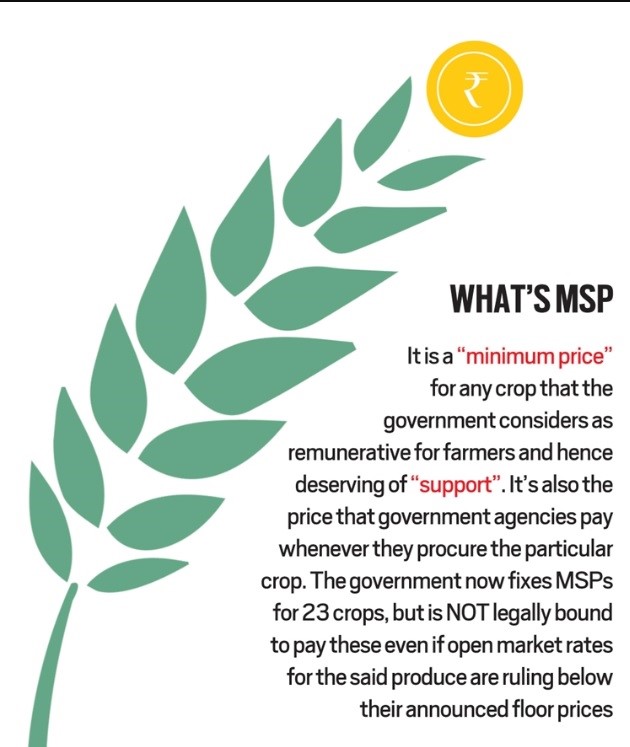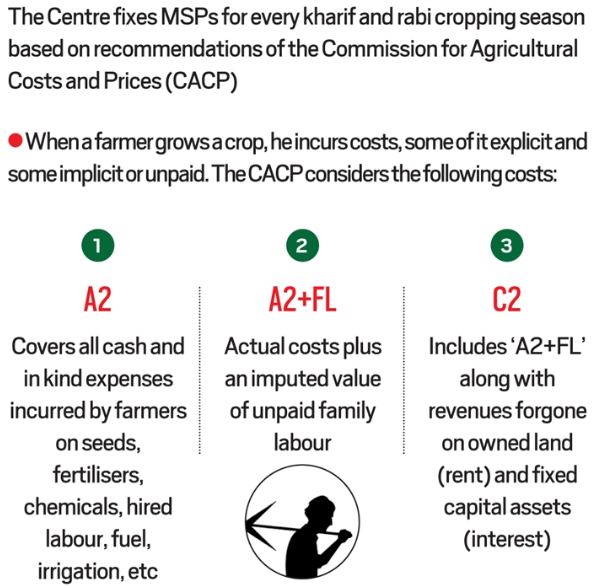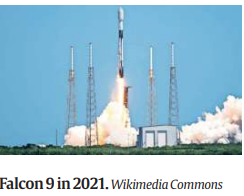15 July 2024 : Daily Current Affairs
1. Bihar Urges Centre to Declare MSP for Makhana and Address Issues at Darbhanga Research Centre
(Source: Indian Express; Section: Govt & Politics; Page: 08)
| Topic: GS3 – Agriculture |
| Context: |
|
Analysis of News:


How are MSPs Determined?
What is the Minimum Support Price (MSP)?
- The MSP is a guaranteed price for their produce from the Government.
- MSP is a form of market intervention by the Government of India to insure agricultural producers against any sharp fall in farm prices.
- MSP in India is a price floor set by the government to ensure that farmers receive a minimum price for their agricultural produce, thereby safeguarding their income and encouraging agricultural production
Crops Under MSP:
- The government announces MSPs for 22 mandated crops and Fair and Remunerative Prices (FRP) for sugarcane.
- The mandated crops are 14 crops of the kharif season, 6 rabi crops and two other commercial crops.
The list of crops is as follows:
- Cereals (7): Paddy, wheat, barley, jowar, bajra, maize and ragi
- Pulses (5): Gram, arhar/tur, moong, urad and lentil
- Oilseeds (8): Groundnut, rapeseed/mustard, toria, soyabean, sunflower seed, sesamum, safflower seed and nigerseed
- Raw Cotton
- Raw Jute
- Copra
- De-husked Coconut
- Sugarcane (FRP)
- Virginia flu-cured (VFC) Tobacco
- Presently, MSPs are notified for 23 crops, but procurement is done for wheat and paddy, which meets the requirements of the public distribution system.
Importance of Makhana Cultivation in Bihar
- About 85% of the country’s makhana production comes from Bihar, particularly from districts like Darbhanga, Saharsa, Madhepura, Supaul, Purnia, Katihar, Araria, Kishanganj, Madhubani, and Sitamarhi.
- Most farmers cultivating the GI-tagged makhana in these areas come from poor backgrounds.
- The state’s MSP demand is significant, especially with the state Assembly polls due next year.
Issues at the ICAR-NRC for Makhana in Darbhanga
- The Bihar government has flagged the “lack” of manpower at the Indian Council of Agricultural Research – National Research Centre (ICAR-NRC) for Makhana in Darbhanga, describing it as being in “bad shape.”
- It emphasized the need to upgrade the centre and suggested changing its administrative headquarters from Ludhiana to Patna.
- Currently, the ICAR-NRC for Makhana has only 10 employees against a sanctioned strength of 42, and it has never had a full-time director.
Historical Context and Current Status of ICAR-NRC for Makhana
- The ICAR-NRC for Makhana in Darbhanga was sanctioned during the IX Five Year Plan period (1997–2002) for the conservation, research, and development of the makhana crop.
- It started functioning in February 2002 but was merged in 2005 under the administrative control of ICAR-Research Complex for Eastern Region (RCER), Patna, which revoked its “national” tag.
- In May 2023, the Central government restored its status as the National Research Centre for Makhana, Darbhanga, and added other aquatic crops, including fish, to its mandate.
- However, the NRC for Makhana was transferred under the administrative control of the ICAR’s Agricultural Engineering Division and attached to the Ludhiana-based ICAR-Central Institute of Post Harvest Engineering & Technology.
Conclusion
- The Bihar government’s push for the MSP for makhana and the improvement of the ICAR-NRC for Makhana underscores the crop’s economic significance to the state.
- Ensuring adequate support and resources for makhana cultivation can boost the livelihoods of farmers and strengthen Bihar’s agricultural sector.
- The response from the Centre and subsequent actions will be crucial in addressing these issues and promoting sustainable development in the region.
| What are the Key Challenges in Legalising MSP? |
|
Financial Burden:
Disincentive for Investment:
Exacerbate Water Scarcity:
Neglect of Non-MSP Crops:
Reduced Export Competitiveness:
Trade Disputes:
|
| PYQ: What do you mean by Minimum Support Price (MSP)? How will MSP rescue the farmers from the low income trap? (150 words/10m) (UPSC CSE (M) GS-3 2018) |
| Practice Question: Discuss the significance of makhana cultivation in Bihar’s economy and the challenges faced by the state in promoting this crop. How can the declaration of Minimum Support Price (MSP) and the improvement of the ICAR-National Research Centre for Makhana in Darbhanga help in addressing these challenges? (250 words/15 m) |
2. On the jurisdiction of the CBI
(Source – The Hindu, International Edition – Page No. – 10)
| Topic: GS2 – Indian Polity – Statutory Bodies |
| Context |
|
Background:
- In a significant ruling on July 10, the Supreme Court upheld the maintainability of a suit filed by the West Bengal government against the Union government’s use of the Central Bureau of Investigation (CBI) within the state, despite the withdrawal of general consent for CBI investigations in 2018.
- This decision addresses the contentious issue of federalism and the powers of the CBI in states where consent has been revoked.
General Consent and CBI’s Jurisdiction:
- General Consent: Under Section 6 of the Delhi Special Police Establishment (DSPE) Act, 1946, the CBI requires prior consent from state governments to conduct investigations within their jurisdictions, except in Union territories and railway areas.
- Several states, including West Bengal, withdrew their general consent, alleging misuse by the Centre against opposition parties.
West Bengal’s Allegations and Suit:
- West Bengal filed an original suit under Article 131 of the Constitution in August 2021, arguing that the Union government’s actions violated its sovereignty by allowing the CBI to register cases despite the withdrawal of consent.
- The state sought the annulment of 12 cases and a bar on further investigations by the agency.
Legal Arguments and Court Proceedings:
- The Union government, represented by the Solicitor General, contended that the CBI operates independently and isn’t under its direct control.
- However, the Supreme Court emphasised that the DSPE Act vests crucial administrative and supervisory powers in the Central government, including the establishment and jurisdiction of the CBI.
Verdict and Implications:
- The apex court ruled that the suit presented a valid cause of action and should proceed to a full hearing on its merits.
- It underscored that while the CBI retains operational autonomy, the Centre’s administrative control over its functioning is significant.
- This decision has broader implications for federal relations, particularly concerning states’ autonomy in policing matters under the Constitution.
Broader Context and Pending Cases:
- The ruling has implications beyond West Bengal, potentially affecting other states that have revoked general consent for CBI investigations.
- It sets a precedent for similar cases pending before the Court, including those involving Central agencies and state police forces in opposition-ruled states like Tamil Nadu.
Conclusion:
- The Supreme Court’s decision affirms the constitutional principles of federalism while recognizing the Central government’s supervisory role over the CBI.
- The final ruling on West Bengal’s suit will likely influence future interactions between Centre and State regarding law enforcement and jurisdictional disputes, impacting the balance of power in India’s federal structure.
| PYQ: The jurisdiction of the Central Bureau of Investigation (CBI) regarding lodging an FIR and conducting probe within a particular State is being questioned by various States. However, the power of the States to withhold consent to the CBI is not absolute. Explain with special reference to the federal character of India. (250 words/15m) (UPSC CSE (M) GS-2 2021) |
| Practice Question: Discuss the significance of the Supreme Court’s recent ruling regarding the use of the CBI in states that have withdrawn general consent. How does this decision impact federalism in India? (250 Words /15 marks) |
3. The Union government’s rein on financial transfers to different States
(Source – The Hindu, International Edition – Page No. – 11)
| Topic: GS2 – Indian Polity – Federal Structure |
| Context |
|
Overview of Recommendations and Actual Transfers
- The Fourteenth Finance Commission recommended a significant increase in devolution to States, from 32% to 42% of Union tax revenues, aiming to enhance fiscal autonomy.
- However, since its implementation in 2015-16, there has been a noticeable reduction in financial transfers from the Union government to States.
Trends in Tax Revenue and State Share
- Despite a doubling of Union gross tax revenue from ₹14.6 lakh crore in 2015-16 to ₹33.6 lakh crore in 2023-24, States’ share increased modestly from ₹5.1 lakh crore to ₹10.2 lakh crore over the same period.
- This disparity highlights a declining trend in the proportion of gross tax revenue allocated to States, from 48.2% to 35.32%.
Impact of Cess and Surcharges
- A significant factor contributing to the reduced state share is the increasing collection from cess and surcharge, which rose from 5.9% (₹85,638 crore) in 2015-16 to 10.8% (₹3.63 lakh crore) in 2023-24.
- These funds, not shared with States, are primarily used for Union government schemes, thus limiting States’ fiscal space.
Centralisation of Public Expenditure
- With reduced devolution and grants-in-aid, the Union government retains more discretionary funds, impacting equity in resource distribution among States.
- Central Sector Schemes (CSec) and Centrally Sponsored Schemes (CSS) further centralise expenditure, totaling ₹19.4 lakh crore in 2023-24, only a fraction of which is devolved to States.
Centrally Sponsored Schemes (CSS) Dynamics
- CSS requires States to match funds, favouring wealthier States capable of contributing, exacerbating inter-state financial disparities.
- Allocation for CSS increased from ₹2.04 lakh crore to ₹4.76 lakh crore between 2015-16 and 2023-24, underscoring the Union government’s influence over State spending priorities.
Central Sector Schemes (CSec) Allocation
- Fully funded by the Union government, CSec schemes saw an allocation rise from ₹5.21 lakh crore to ₹14.68 lakh crore, demonstrating significant centralised financial control.
- Direct state allocation under CSec schemes remained limited to ₹60,942 crore in 2023-24, highlighting minimal state autonomy in these areas.
Anti-Federal Fiscal Policies Concerns
- Non-statutory grants through CSS and CSec schemes, amounting to 12.6% of gross tax revenue, are tied to specific schemes, limiting State flexibility in public expenditure.
- Combined with a fiscal deficit of 5.9% of GDP, the Union government retains substantial financial power with comparatively limited expenditure obligations.
Outlook and Future Challenges
- The Fifteenth Finance Commission retained the States’ share at 41% (42% including J&K and Ladakh), despite Union government pressures for downward revisions.
- This scenario raises concerns about cooperative federalism and equitable resource distribution among States, crucial for balanced economic growth and development.
Conclusion
- The evolution of financial transfers from the Union government to States since the Fourteenth Finance Commission reflects a complex interplay of increased tax revenues, rising cess and surcharge collections, and centralised expenditure through CSS and CSec schemes.
- While recommendations aimed to empower States financially, actual transfers have not proportionately increased, leading to concerns over equity and autonomy in state finances.
- As debates continue over fiscal federalism, ensuring fair resource allocation remains pivotal for sustainable and inclusive national development.
| Practice Question: Discuss the impact of reduced financial transfers to states post the Fourteenth Finance Commission on India’s cooperative federalism and fiscal autonomy. (150 Words /10 marks) |
PRELIMS FACTS
1. FAA Grounds SpaceX’s Falcon 9 After Engine Failure Strands Starlink Satellites
(Source: Indian Express; Section: Explained; Page: 14)
| Context: |
|
Analysis of News:

What is Falcon 9?
- Falcon 9 is a partially reusable rocket designed and manufactured by Elon Musk’s SpaceX company.
- It can transport crew and payloads to low Earth orbit (an altitude of 2000 km or less) and beyond.
The rocket has two stages:
- The first stage, or booster stage, comprises nine Merlin engines and aluminum-lithium alloy tanks containing liquid oxygen and rocket-grade kerosene propellant.
- The second stage consists of a single Merlin engine. The first stage is reusable and capable of re-entering the atmosphere and landing vertically after separating from the second stage.
What are Starlinks?
- The Starlink project by SpaceX aims to create a broadband network using a collection of thousands of circling spacecraft.
- The Starlink satellites are equipped with Hall thrusters, which are used to manoeuvre in orbit, maintain altitude, and guide the spacecraft back into the atmosphere after their missions. Hall thrusters generate an impulse using electricity and krypton gas.
Starlink Project:
- The goal of the project is to create a low-cost, satellite-based broadband network that can provide global internet access. 42,000 satellites will eventually be part of the Starlink network.
- In Low Earth Orbit, the Starlink satellites will be placed in an altitude range between 350 km and 1,200 km (LEO). Up to 2,000 kilometres are covered by the LEO.
- Reduced latency between a user seeking data and the server transmitting that data is the key benefit of placing satellites in LEO for space-based Internet.
- However, LEO has a significant drawback. They are less tall, therefore their signals only reach a small region. To send signals to every corner of the world, a lot more satellites are therefore required.
- SpaceX says it can start services on a small scale once 400 satellites join the network.
- Once operational, space-based Internet networks are expected to change the face of the Internet.
2. Former President Donald Trump Survives Assassination Attempt at Pennsylvania Rally; Shooter Killed by Secret Service
(Source: Indian Express; Section: Explained; Page: 14)
| Context: |
|
Analysis of News:
The US Secret Service
History and Mandate
- The United States Secret Service, established in 1865, is one of the oldest federal investigative law enforcement agencies in the world.
- Initially tasked with combating the counterfeiting of US currency, its mandate shifted to presidential protection after the assassination of President William McKinley in 1901.
- The assassinations of Presidents Abraham Lincoln and James A. Garfield in 1865 and 1881, respectively, also underscored the need for presidential security.
- Since 1902, the Secret Service has been responsible for the full-time protection of the US President.
Scope of Protection
- The Secret Service operates under the Department of Homeland Security and employs around 3,200 special agents, 1,300 Uniformed Division officers, and over 2,000 technical, professional, and administrative support personnel.
- Besides the President, the agency protects the Vice President, President-elect, their immediate families, former Presidents and their spouses (unless remarried), and children of former Presidents until age 16.
- Major presidential and vice-presidential candidates and their spouses also receive protection within 120 days of a general presidential election.
Operational Tactics
Protective Measures
- The Secret Service has the authority to carry firearms and make arrests without warrants based on reasonable grounds.
- Their protective strategy involves meticulous advance work and threat assessments to identify potential risks.
- The US military supports the Secret Service with Explosive Ordnance Disposal teams and communication resources, while local police assist in securing venues for events like campaign rallies.
3. Amit Shah Inaugurates PM College of Excellence in Madhya Pradesh, Highlights NEP’s Role in Making India a Developed Nation by 2047
(Source: Indian Express; Section: Express Network; Page: 12)
| Context: |
|
Analysis of News:
Advocacy for the New Education Policy
- During his address, Shah emphasized the importance of the NEP in shaping the future of education in India.
- He urged students to download the NEP document to learn how to “think out of the box.”
- Shah underscored that Prime Minister Modi’s goal is to make India a developed nation by the time it celebrates 100 years of independence in 2047, and the NEP is a crucial element in achieving this target.
- He praised the NEP for its focus on quality over quantity and its potential to elevate Indian students to international standards while preserving their cultural roots.
What is NEP 2020?

- The NEP 2020 aims at making “India a global knowledge superpower”. It is only the 3rd major revamp of the framework of education in India since independence.
- The two earlier education policies were brought in 1968 and 1986.
Salient Features:
- Ensuring Universal Access at All Levels of schooling from pre-primary school to Grade 12.
- Ensuring quality early childhood care and education for all children between 3-6 years.
- New Curricular and Pedagogical Structure (5+3+3+4) corresponds to the age groups of 3-8, 8-11, 11-14, and 14-18 years respectively.
- It covers four stages of schooling: Foundational Stage (5 years), Preparatory Stage (3 years), Middle Stage (3 years), and Secondary Stage (4 years).
- No hard separations between arts and sciences, between curricular and extra-curricular activities, between vocational and academic streams;
- Emphasis on promoting multilingualism and Indian languages
- Setting up of a new National Assessment Centre, PARAKH (Performance Assessment, Review, and Analysis of Knowledge for Holistic Development)
- A separate Gender Inclusion fund and Special Education Zones for disadvantaged regions and groups
Implementation and Impact
- Shah acknowledged that the 55 colleges inaugurated meet all parameters for providing top-quality, practical, and modern education.
- He expressed optimism that today’s children will witness India’s evolution into a great nation by 2047, even if the current leaders might not be around to see it.
- Shah also praised Madhya Pradesh for being the first state to implement the NEP under the leadership of Chief Minister Shivraj Singh Chouhan and former state higher education minister Mohan Yadav.
State-Level Educational Initiatives
Madhya Pradesh’s Achievements
- Shah commended Madhya Pradesh for initiating medical and engineering courses in Hindi, benefiting students who are more comfortable with the language.
- This move aligns with the NEP’s goal of making education accessible and inclusive.
- The state’s proactive approach in adopting and implementing the NEP sets a precedent for other states to follow, showcasing its commitment to enhancing the educational landscape.
What are the Major Initiatives Taken Under NEP 2020?
PM Schools for Rising India (SHRI):
- PM-SHRI scheme aims to provide high-quality education in an equitable, inclusive, and joyful school environment.
- It is a centrally sponsored scheme launched in September 2022 for upgradation and development of more than 14500 Schools across the country. Rs. 630 crore has been allocated to upgrade schools under the PM SHRI initiative.
NIPUN Bharat:
- The vision of National Initiative for Proficiency in Reading with Understanding and Numeracy(NIPUN) Bharat Mission is to create an enabling environment to ensure the universal acquisition of foundational literacy and numeracy, so that every child achieves the desired learning competencies in reading, writing, and numeracy by the end of Grade 3, by 2026-27.
PM e-VIDYA:
- The initiative aimed to promote online education and digital learning by providing various e-learning platforms like DIKSHA and offering e-books and e-contents to students across the country.
NCF FS and Jadui Pitara:
- Launch of National Curriculum Framework for Foundational Stage (NCF FS) and Jadui Pitara for play-based learning teaching material tailored for children between the age group of 3 to 8 years
NISHTHA:
- The National Initiative for School Heads’ and Teachers’ Holistic Advancement (NISHTHA) is a capacity-building program for teachers and school principals in India.
NDEAR:
- National Digital Education Architecture (NDEAR), an architectural blueprint, that lays down a set of guiding principles and building blocks to enable the creation of digital technology-based applications pertaining to education.
Academic Frameworks:
- Introduction of National Credit Framework (NCrF) and National Higher Education Qualification Framework (NHEQF) to facilitate credit transfer and academic flexibility.
Increased Investment in Education:
- The policy advocates for both the Central government and State Governments to allocate a combined 6% of GDP to education.
- In alignment with this vision, the Ministry of Education has witnessed a budget of Rs. 1,12,899 crore in 2023-24, indicating a 13.68% increment from 2020-21.
International Campuses and Partnerships:
- NEP 2020 supports Indian universities in establishing campuses abroad and inviting foreign institutions to operate in India.
- Memoranda of Understanding (MoUs) have been signed for the establishment of IIT campuses in Zanzibar and Abu Dhabi, reflecting India’s global educational outreach.
Educational Innovation in GIFT City:
- NEP 2020’s innovative approach extends to Gujarat’s GIFT City, where world-class foreign universities and institutions are permitted to offer specialized courses.
- This move, free from domestic regulations, aims to nurture high-end human resources for financial services and technology.
4. Palimpsest: a historic emblem of reuse
(Source – The Hindu, International Edition – Page No. – 4)
| Context |
|
What is a palimpsest:
- Definition: A palimpsest is a page or manuscript from which the original text has been scraped or washed off to make room for new writing.
- Historical Use: Historically, parchment made from untanned animal skins, especially goats, was expensive, leading to its reuse.
- Methods of Erasure:
- Early methods involved using milk and oat bran to wash off text, often leaving faint traces known as underwriting.
- In the late mediaeval period, pumice was used to scrape off text more permanently.
- Scholarly Importance: Modern scholars decipher underwriting to access historical texts, employing techniques like machine learning.
- Famous Examples: Notable works that have survived as palimpsests include the Sana’a palimpsest, the Archimedes palimpsest, and Cicero’s ‘De re publica’.
- Metaphorical Use: The term is used in other fields:
- Astronomy: Refers to eroded craters on planetary bodies.
- Geology: Describes natural features created by successive structures at the same location over time.
5. A celebration of indigenous seeds sows change in the farm landscape
(Source – The Hindu, International Edition – Page No. – 6)
| Context |
|
Analysis of the news:
- A popular movement to preserve indigenous seed varieties is gaining momentum in southern Rajasthan’s tribal regions, promoting crop diversity and climate resilience.
- Thousands of tribal people from nearly 1,000 villages in Rajasthan, Madhya Pradesh, and Gujarat participated in Beej Utsavs (seed festivals) in late June.
- 90 such events were held, focusing on preserving indigenous seeds for different crop seasons.
- In Sera Nagla village, Banswara district, the Bheel community exchanged millet seeds, promoting the practice of sharing and preserving indigenous seeds.
- Participants were encouraged to educate others and integrate indigenous seeds into their agricultural practices.
- Jayesh Joshi, secretary of Vaagdhara, emphasised the importance of indigenous seeds amid multinational influences, highlighting their local compatibility and sustainability.
- Vaagdhara organised the events with support from tribal rights groups.
- Over 50 indigenous seed varieties were showcased, including grains, pulses, and vegetables.
- Farmers preserving seeds were honoured as Beej Mitra and Beej Mata.





